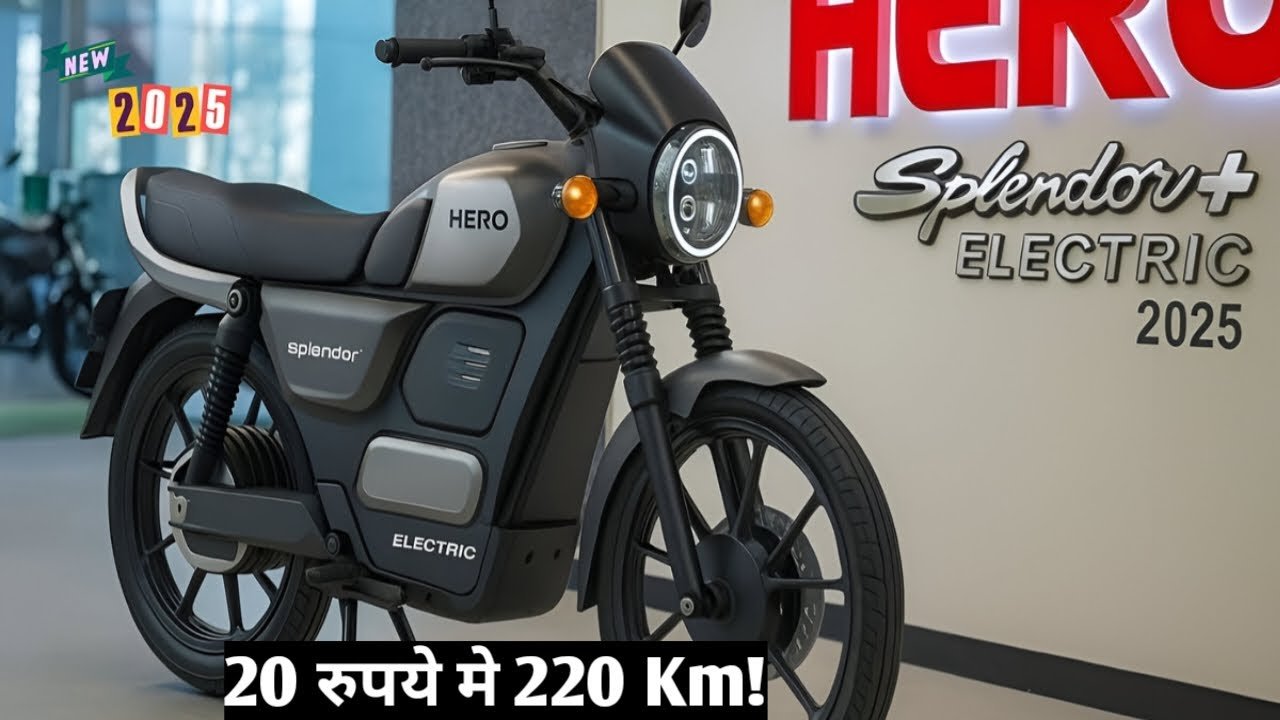The Hero Splendor has long been the heartbeat of Indian roads, dominating the commuter segment for decades with its unmatched practicality, reliability, and affordability. Now, Hero MotoCorp is preparing to write a new chapter in this legacy by introducing the electric version of its most iconic motorcycle, the Hero Splendor Electric. Expected to hit the market by 2027, this upcoming bike aims to blend the familiar design and dependable performance of the petrol Splendor with the modern efficiency and eco-friendly appeal of an electric drivetrain. For millions of daily riders, college students, delivery workers, and office commuters, the Splendor Electric promises to be a game-changing option that combines low running costs with the comfort of a trusted name.
In terms of design, Hero is unlikely to stray too far from the tried-and-tested formula that made the Splendor a household name. The company understands that riders love its simple, classic commuter styling, so the electric version is expected to retain the same timeless look while offering subtle modern enhancements. Industry reports suggest the Splendor Electric may feature LED headlamps for better visibility, alloy wheels for a contemporary touch, and a fully or semi-digital instrument cluster to keep riders updated with speed, battery percentage, and range in real time. The upright seating posture, strong steel frame, and commuter-friendly ergonomics that made the original Splendor so comfortable for everyday use are expected to remain intact, ensuring that long-time fans of the bike feel instantly at home. In short, the design philosophy will be about maintaining familiarity while adding just enough modern flavor to make the bike feel fresh and future-ready.
Performance-wise, the Splendor Electric is clearly being developed for city riders who prioritize convenience and efficiency over raw speed. While Hero has not officially revealed the complete specifications, reports from the auto industry hint at a motor power in the range of 3 to 4 kW, which is more than adequate for navigating Indian city traffic. The bike is expected to reach a top speed of 70 to 80 km/h, making it commuter-friendly while also keeping the focus on battery life and range rather than thrill-seeking performance. On a single charge, the Splendor Electric could deliver an impressive 100 to 120 kilometers of range, a figure that will be more than enough for most urban riders who typically travel short distances each day. Powering this setup will likely be a removable lithium-ion battery pack, designed to make charging simple and practical. Riders will be able to plug it into a standard home socket, with a full charge taking around four to five hours. The removable battery adds a layer of convenience, especially for city dwellers who might not have direct parking access with charging points.
On the features and safety front, Hero is expected to offer a set of practical additions that enhance the overall riding experience. Apart from LED lighting and a semi-digital console, riders could also benefit from regenerative braking technology, which helps recharge the battery while slowing down. USB charging support for smartphones and small devices may also be offered, catering to the growing needs of modern commuters. Most importantly, the Hero brand itself comes with the assurance of one of the widest after-sales service networks in India. This means that maintenance and servicing will be easy, affordable, and accessible even in smaller towns and rural areas, something that most new electric startups struggle to provide.
Perhaps the biggest talking point for potential buyers will be the price. Early reports suggest that the Hero Splendor Electric may launch with an ex-showroom price of around one lakh rupees, placing it firmly in the affordable electric two-wheeler category. This aggressive pricing strategy will allow it to compete directly with established players such as Revolt RV400, Ampere Primus, Ola Roadster, and Oben Rorr EZ. However, Hero’s competitive edge will not only lie in pricing but also in its decades-long trust factor and the legendary reliability of the Splendor brand. For riders who are hesitant to switch from petrol to electric, the comfort of buying from a trusted brand like Hero may prove to be the deciding factor.
As far as the timeline goes, the Hero Splendor Electric has already been under development for more than two years at Hero’s state-of-the-art R&D facility in Jaipur. The company has set ambitious goals for this bike, with plans to launch it by 2027 and scale production up to 200,000 units annually. This launch also ties into Hero’s larger electric vehicle strategy, which targets sales of over half a million electric two-wheelers by 2028.
In conclusion, the Hero Splendor Electric represents the natural evolution of India’s most beloved commuter bike. By maintaining its affordability, practicality, and reliable design while embracing the eco-friendly future of mobility, Hero is positioning the Splendor Electric to become a bestseller from the day it launches. With a decent 120 km range, quick charging options, and Hero’s strong service network, this electric bike is expected to appeal to millions of riders who are ready to transition from petrol to electric without compromising on trust, comfort, or cost-effectiveness. While it may not excite speed enthusiasts or thrill-seekers, the Splendor Electric is poised to become a revolution on Indian roads, continuing the legacy of the Splendor brand for a new generation of eco-conscious commuters.

